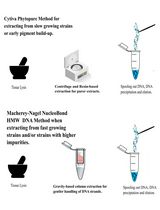- EN - English
- CN - 中文
Visualization of the Evolution and Transmission of Circulating Vaccine-Derived Poliovirus (cVDPV) Outbreaks in the African Region
非洲地区疫苗衍生脊髓灰质炎病毒(cVDPV)暴发的演化与传播可视化分析
发布: 2025年07月05日第15卷第13期 DOI: 10.21769/BioProtoc.5376 浏览次数: 1789
评审: Alba BlesaAnonymous reviewer(s)

相关实验方案

优化高分子量 DNA 提取方法以用于 Magnaporthaceae 及其他禾本科根部真菌的长读长全基因组测序
Michelle J. Grey [...] Mark McMullan
2025年03月20日 3118 阅读

番茄内生菌Streptomyces sp. VITGV100中吲哚类代谢产物的合成与提取分析
Veilumuthu Pattapulavar [...] John Godwin Christopher
2025年07月20日 2267 阅读
Abstract
Since the creation of the Global Polio Eradication Initiative (GPEI) in 1988, significant progress has been made toward attaining a poliovirus-free world. This has resulted in the eradication of wild poliovirus (WPV) serotypes two (WPV2) and three (WPV3) and limited transmission of serotype one (WPV1) in Pakistan and Afghanistan. However, the increased emergence of circulating vaccine-derived poliovirus (cVDPV) and the continued circulation of WPV1, although limited to two countries, pose a continuous threat of international spread of poliovirus. These challenges highlight the need to further strengthen surveillance and outbreak responses, particularly in the African Region (AFRO). Phylogeographic visualization tools may provide insights into changes in poliovirus epidemiology, which can in turn guide the implementation of more strategic and effective supplementary immunization activities and improved outbreak response and surveillance. We created a comprehensive protocol for the phylogeographic analysis of polioviruses using Nextstrain, a powerful open-source tool for real-time interactive visualization of virus sequencing data. It is expected that this protocol will support poliovirus elimination strategies in AFRO and contribute significantly to global eradication strategies. These tools have been utilized for other pathogens of public health importance, for example, SARS-CoV-2, human influenza, Ebola, and Mpox, among others, through real-time tracking of pathogen evolution (https://nextstrain.org), harnessing the scientific and public health potential of pathogen genome data.
Key features
• Employs Nextstrain (https://nextstrain.org), which is an open-source tool for real-time interactive visualization of genome sequencing datasets.
• First comprehensive protocol for the phylogeographic analysis of poliovirus sequences collected from countries in the World Health Organization (WHO) African Region (AFRO).
• Phylogeographic visualization may provide insights into changes in poliovirus epidemiology, which can in turn guide the implementation of more strategic and effective vaccination campaigns.
• This protocol can be deployed locally on a personal computer or on a Microsoft Azure cloud server for high throughput.
Keywords: Poliovirus (脊髓灰质炎病毒)Background
Significant progress has been made toward a poliovirus-free world since the creation of the Global Polio Eradication Initiative (GPEI) in 1988 [1]. GPEI efforts have resulted in the eradication of wild poliovirus (WPV) serotypes two (WPV2) and three (WPV3) and limited transmission of serotype one (WPV1) in Pakistan and Afghanistan [1]. However, the increased emergence of circulating vaccine-derived poliovirus (cVDPV) outbreaks and the continued circulation of WPV1 pose a continuous threat of international spread [2,3]. For example, WPV1 viruses showing a direct link to the viruses circulating in Pakistan have been isolated from stool samples collected in Malawi and Mozambique in November 2021 and March 2022, respectively (https://www.who.int/emergencies/disease-outbreak-news/item/wild-poliovirus-type-1-(WPV1)-malawi). Additionally, cVDPV serotype 2 (cVDPV2) isolates from environmental samples in five countries in the WHO European Region (EURO) have recently been genetically linked to cVDPV2 strains circulating in the World Health Organization (WHO) African Region (AFRO) [4].
The importation of WPV1 into WHO AFRO and the exportation of cVDPV2 from WHO AFRO to WHO EURO highlight the need to further strengthen surveillance and outbreak responses. Furthermore, there is a need for novel strategies to guide the implementation of more strategic and effective vaccination campaigns. Genetic sequencing of cVDPVs from stool and wastewater samples is a useful tool employed for the confirmation of poliovirus detection, identification of cVDPV origins, and tracking of geographic spreading patterns [5,6]. It is also important for the determination of appropriate and most effective vaccination strategies [6]. For example, it is possible to infer which cVDPV outbreak cases are due to local transmissions and which are more likely to be linked to chains of cVDPV transmission in other countries. Phylogeographic methods are based on Nextstrain real-time tracking of pathogen evolution (https://docs.nextstrain.org/en/latest/index.html) [7] and Bayesian evolutionary analysis sampling trees (BEAST) (https://beast.community/about) to infer the origins and geographic spread of cVDPVs between and within WHO AFRO countries [5]. These methods employ discrete trait analysis (DTA), which can provide information on the geographic history of viral spread and associated rates of transmission [5]. Starting from geolocated virus sequences, this approach allows inference of the location of internal nodes in phylogenetic trees [5,7]. DTA has previously been applied to inform viral diffusion for several infectious diseases, including SARS-CoV-2, human and animal influenza, Mpox, and Ebola (https://nextstrain.org), and is considered a powerful tool for molecular epidemiology of pathogens.
Regular updates of the cVDPV surveillance sequence data using phylogeographic visualization tools may provide insights into changes in poliovirus epidemiology, which can in turn guide the implementation of more strategic and effective supplementary immunization activities and improved outbreak response and surveillance. These analyses may be particularly relevant to halt the ongoing outbreaks of cVDPVs in WHO AFRO through improved surveillance and timely and effective outbreak response, possibly achieving the global poliovirus eradication efforts of the GPEI. With this goal in mind, we created a comprehensive protocol for the phylogenetic and phylogeographic analysis of poliovirus sequence datasets using Nextstrain [7], a powerful open-source tool for the real-time interactive visualization of genome sequencing data. Approaches for phylogeographic visualization of poliovirus in WHO AFRO are detailed in this protocol.
Equipment
We used shell commands on a Linux-based operating system with superuser privileges.
Computational requirements: We used a workstation or a server with a 64-bit Linux-based operating system, possessing 12 GB RAM and sufficient hard disk space (at least 500 GB) to store the files used and produced in the analysis. The commands given in this analysis protocol were validated on Ubuntu (24.04 LTS) Linux Distribution running on a Microsoft Azure cloud server (https://azure.microsoft.com/en-gb) and on a personal laptop running the same system.
Software and datasets
1. Required software
This protocol uses the following tools and Nextstrain software to perform the phylogeographic analysis:
a. Anaconda (https://github.com/conda/conda)
b. Nextstrain https://github.com/nextstrain [7]
c. Augur https://github.com/nextstrain/augur [7]
d. Auspice https://github.com/nextstrain/augur [7]
e. MAFFT (https://github.com/GSLBiotech/mafft [8]
f. IQTREE http://www.iqtree.org [9]
All requisite tools and their dependents were installed (personal computer or workstation) before proceeding with the analysis.
2. Datasets
The protocol uses the poliovirus VP1 gene sequence datasets made publicly available by the National Center for Biotechnology Information (NCBI): https://www.ncbi.nlm.nih.gov/nucleotide/ for development. Similar datasets are routinely generated in AFRO-supported laboratories in WHO AFRO under the supervision of the global network of poliovirus laboratories (Global Poliovirus Laboratory Network, GPLN).
The installation steps for all tools used in this protocol and the instructions for downloading the requisite datasets are given in the following section.
Procedure
文章信息
稿件历史记录
提交日期: Apr 7, 2025
接收日期: Jun 5, 2025
在线发布日期: Jun 26, 2025
出版日期: Jul 5, 2025
版权信息
© 2025 The Author(s); This is an open access article under the CC BY license (https://creativecommons.org/licenses/by/4.0/).
如何引用
Owuor, D. C., Tesfaye, B., Wakem, A. Y. D., Kabore, S., Ikeonu, C. O., Doussoh, M. E. F. G. E., Sigala, P. E. M. B., Ibrahim, I. I., Jimoh, A., Ndumba, I., Khumalo, J., Oviaesu, D. O., Kipchirchir, C., Gathenji, C., Kipterer, J., Touray, K., Abdullahi, H., Rankin, K., Diop, O. M., Chia, J. E., Modjirom, N., Ahmed, J. A. and Kfutwah, A. K. (2025). Visualization of the Evolution and Transmission of Circulating Vaccine-Derived Poliovirus (cVDPV) Outbreaks in the African Region. Bio-protocol 15(13): e5376. DOI: 10.21769/BioProtoc.5376.
分类
生物信息学与计算生物学
微生物学 > 微生物遗传学 > 全基因组测序
环境生物学 > 病毒
您对这篇实验方法有问题吗?
在此处发布您的问题,我们将邀请本文作者来回答。同时,我们会将您的问题发布到Bio-protocol Exchange,以便寻求社区成员的帮助。
Share
Bluesky
X
Copy link








